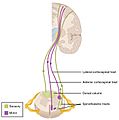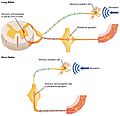Central nervous system facts for kids
Quick facts for kids Central Nervous System |
|
|---|---|
 |
|
| Schematic diagram showing the central nervous system in yellow, peripheral in orange | |
| Latin | Systema nervosum centrale pars centralis systematis nervosi |
| Lymph | 224 |
| MeSH | 197 |
| Code | WM1 |
The central nervous system (CNS) is like the main control center of your body. It includes your brain and your spinal cord.
Working with the peripheral nervous system, the CNS helps control everything you do, think, and feel. It's protected by strong bones: your skull protects your brain, and your backbone protects your spinal cord.
Contents
What Makes Up Your CNS?
Your central nervous system has two main parts: the brain and the spinal cord. These two parts work together to send and receive messages throughout your body.
The Brain: Your Body's Command Center
Your brain is an amazing organ. It helps you think, learn, remember, and feel emotions. It also controls your movements, senses, and many body functions.
It has different sections, each with special jobs:
- The cerebrum is the largest part. It handles thinking, language, and voluntary movements.
- The cerebellum helps with balance and coordination.
- The brainstem connects the brain to the spinal cord. It controls vital functions like breathing and heart rate.
The Spinal Cord: The Information Highway
The spinal cord is a long, thin bundle of nerves. It runs down your back, protected by your vertebrae.
The spinal cord acts like a super-fast highway. It carries messages between your brain and the rest of your body. These messages tell your muscles to move or tell your brain what your senses are feeling.
Some actions, like reflexes, happen so fast they don't even need to go all the way to your brain first! The spinal cord can handle these quick reactions on its own.
How the CNS Works
The CNS is always busy. It processes information from your senses. For example, when you touch something hot, your nerves send a message to your spinal cord. The spinal cord quickly sends a message back to your hand to pull away. It also sends the message to your brain so you feel the heat.
Your CNS helps you learn new things. It helps you remember facts for a test. It even helps you feel happy or sad. It's involved in every single thing you do!
Images for kids
-
Different ways in which the CNS can be activated without engaging the cortex, and making us aware of the actions. The above example shows the process in which the pupil dilates during dim light, activating neurons in the spinal cord. The second example shows the constriction of the pupil as a result of the activation of the Eddinger-Westphal nucleus (a cerebral ganglion).
-
A map over the different structures of the nervous systems in the body, showing the CNS, PNS, autonomic nervous system, and enteric nervous system.
See also
 In Spanish: Sistema nervioso central para niños
In Spanish: Sistema nervioso central para niños







